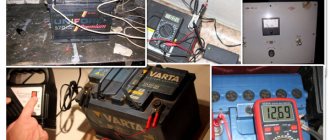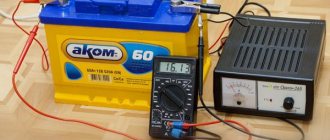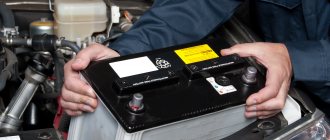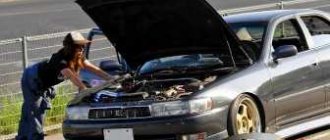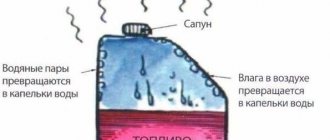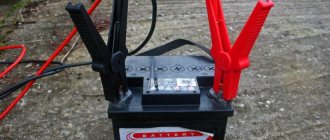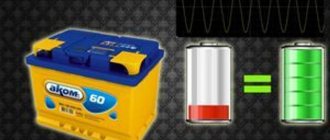Rechargeable batteries are used everywhere. In conventional portable devices, batteries do not require additional maintenance. In the case of car batteries, you should carefully monitor its condition and, if necessary, add distillate. To do this correctly and not cause irreparable damage to the battery, you should know how to add distilled water to the battery.
What is distilled water
Distillate or distilled water is a liquid without impurities. This substance is pure water, which does not contain salts, minerals or impurities. Due to this, such a liquid is not capable of conducting electric current and is a dielectric.
Distilled water is added to the battery because it is initially contained there along with a certain amount of sulfuric acid. The acid acts as a conductor, and water simply dilutes it to the required concentration. Collectively, these fluids constitute an electrolyte.
But during battery operation, water tends to evaporate and its percentage relative to acid decreases. As a result, the density of the electrolyte increases. That is why motorists quite often independently replenish the level of distillate in the battery.
Factors affecting distillate volume
When operating batteries that use distilled water inside the cans, you need to be aware of the reasons for the decrease in level . Most often this pathological process is observed:
- At high air temperatures.
- When the battery is overheated as a result of charging or discharging with high currents.
- Depressurization of the housing.
- When driving the vehicle on a bumpy road.
- As a result of excessive angular tilt of the machine.
To a small extent, the level of distilled water can also be influenced by atmospheric pressure and air humidity.
How to replace distillate
Quite often on the Internet you can find different liquids that are proposed to replace distilled water. Among them are the following:
- Freshly collected rainwater.
It is believed that such a liquid contains no minerals or salts.
- Boiled water.
Some people believe that once water is heated to 100 degrees, it becomes distilled.
- Plain water.
There are opinions that ordinary tap drinking water is not capable of harming the battery, and it is quite functional with such liquid.
- Melt water.
It is generally accepted that after freezing, no impurities or salts remain in the water.
In fact, nothing can replace distilled water. Any action with a liquid cannot 100 percent get rid of minerals, salts and other impurities. This is almost impossible without the use of special equipment and techniques. Tap or rain water, even after being in a different state of aggregation, is not able to be cleansed of absolutely all impurities.
Melt water and water collected during rain will still contain dirt and dust. After filling the battery, these impurities will settle on the surface of the plates, reducing their working area. Boiled water, and especially ordinary water, always contains salts and minerals. Such substances violate the standard properties of the electrolyte and are also deposited on the battery plates if you use it instead of distilled one.
You can try making distilled water yourself. But it is much easier and less energy-consuming to purchase liquid at a car dealership. It is very cheap and has a long shelf life. One small canister is enough for a long time.
Why is no electrolyte used?
During the operation of the battery, especially in the summer, the battery heats up, as a result of which the jars may boil. The DW evaporates at this moment. Acid is a non-volatile liquid; accordingly, it remains and the concentration of water decreases. The density of the mixture sometimes increases to 1.4 g/cm
3
. Therefore, in order to bring the electrolyte to normal density, it is necessary to add DV.
If you pour electrolyte, the density will decrease, but not enough.
It is important to remember about salt precipitation and destruction of the plates. Therefore, in order to reduce the density of the liquid to the established norm, only DV is added. This rule must always be remembered!
It is also worth remembering that water is added only to batteries of the type being serviced, which are characterized by maximum evaporation. Maintenance-free batteries are equipped with a molded sealed case; the evaporated liquid does not come out, it precipitates inside the can. In this case, a closed cycle occurs; there is no need to add water.
This is interesting: Pads in the caliper rattle after replacement: reasons, what to do
Why do they pour water into the battery? Reasons
Distilled water in the battery is a component necessary for the performance of the electrolyte and battery. It is standard that the electrolyte contains 65% distillate and only 35% sulfuric acid. This ratio of water and acid allows you to maintain optimal electrolyte density.
Sulfuric acid is a very dangerous and aggressive compound. It cannot be used in its pure form, as this will quickly destroy the battery. After adding water to the battery, the acid concentration in the electrolyte decreases and allows it to perform its functions through the current wire without damaging the plates.
Important! If you need to fill the battery with liquid to the required level, then water is chosen for this. You should not pour pure acid into the battery, even if this is required to increase the density. For such a case, there is a correction electrolyte solution.
But unlike acid, water can evaporate from the battery during battery use. This in turn increases the density of the conductive fluid, which can negatively affect the plates. This is why it is necessary to add distilled water to the battery. This keeps it running.
Also, water boils away if you recharge the battery. That is why it is worth using the battery according to all the rules. This will help the device operate normally.
How much distilled water should I add to the battery?
In modern batteries, it is quite easy to understand exactly how much distilled water needs to be added to the battery. There are varieties of batteries with a transparent case on which marks are applied. If the battery does not have a transparent case, it must have a metal or plastic tongue located below the neck. In such a battery, the electrolyte level should be 0.5 cm above this mark.
If there are no marks on the battery indicating the required electrolyte level. In this case, it is necessary to add water so that the total volume of liquid covers the plates by 1.5-2 cm.
You can determine the level using a glass tube. It is necessary to lower it to the lead plate and clamp the end from the outside with your finger. Then take it out. The remaining liquid in the tube will be the level above the plates. The tube is required to be filled to 2 cm.
Important! It is worth carefully monitoring the fluid level in the battery, as well as the density of the electrolyte. A lack of distillate will have a bad effect on the condition of the plates. And its excess undermines the battery's performance. Also, in cold weather, highly diluted electrolyte can freeze.
How to add distilled water to a car battery correctly
If the density of the electrolyte has increased or the battery does not provide the required voltage, you should add distillate. Its deficiency causes such symptoms in batteries. Correct filling of water into the battery occurs according to the following scheme:
- Remove dirt and dust from the surface of the battery. It is especially worthwhile to thoroughly wipe the areas around the lids. It is better to wipe the necks with a napkin soaked in water and soda; this will neutralize the acid on this part of the battery, which could get there during the charging process.
- Carefully unscrew the plugs and set aside.
- Using a glass tube, check the electrolyte level in each jar.
- Using a syringe or syringe, add distilled water from a jar with insufficient level. Then check the fluid level again.
- Leave the battery for a couple of hours. Tighten the plugs. This time is necessary for everything to mix evenly during diffusion.
- After this time, it is necessary to check the density of the electrolyte. It should be approximately the same in each compartment, tolerances of 0.01 are allowed.
- After all manipulations, the battery must be charged.
It is worth relying on the instructions on how to add water to the battery. This will help you do everything as carefully and correctly as possible. You should also definitely charge the battery after topping up. This will allow you to evaluate how well the battery holds its charge.
Important! Filling the distillate into the battery should be done when the battery is standing on a flat horizontal surface. This will allow you to check the level correctly.
Adding distilled water to equalize the density of the electrolyte in a car battery is a fairly simple procedure. But you still shouldn’t neglect simple safety methods like safety glasses and gloves.
You may also be interested
.
Batteries 0
What level should the battery be?
In a 55 Ah battery, the optimal amount of content is about 2.5 liters.
An equal amount of distilled water is poured into each battery jar .
If a 12-volt battery is used, then to obtain the required voltage, the battery will consist of 6 series-connected banks. Accordingly, each cell will have 416 ml.
Obtaining distillate at home
There are motorists who do not go to the store for DV.
They produce it themselves at home. This is mainly the older generation, who lived through times of shortage, and people living in settlements remote from the city, where many products simply do not arrive. If you want to prepare DV yourself, you should understand that it will not be of high quality, since for this you need to have special expensive equipment - a distiller. But as an alternative, a regular moonshine still without a coil is suitable. The productivity of the DV when using this option will be approximately 1 glass in 3-4 hours.
The formula of distilled water is H2O. A high-quality liquid should not contain foreign impurities. It is impossible to achieve such a result under domestic conditions; a small content of metal salts will still remain.
Recommendations:
- If you urgently need to add water to the battery, you can take it from the tap into a plastic bottle and put it in the freezer for 2-3 hours. You should only use ice that has been melted beforehand. Unfrozen water is drained into the sink. The DV obtained in this way will cause minimal damage to the battery.
- Another way is to collect rainwater in a plastic container, carefully filter it, and then use it for its intended purpose.
Important! The collected water for the battery should not come into contact with iron objects. For example, water running off the metal roof of a house is not suitable for this purpose.
Adding water or electrolyte
If a sufficiently large amount of electrolyte was discharged in the form of steam through the high-pressure relief valves, then you will have to look for a method for topping up the liquid, and as was said earlier, maintenance-free batteries do not have plugs.
In this case, you will have to do them yourself. The best way is drilling. It is carried out in several stages so that the chips do not get into the contents of the cans (first we take a very small drill, and then a larger one).
It is not necessary to make larger holes, since distilled water can be poured through a regular syringe. After the liquid hides the plates and is corrected, you can seal the holes with durable silicone.
The procedure for correcting the volume and composition of the battery contents is carried out in the following cases:
- if it is visually noticeable that there is less electrolyte in one jar;
- the voltage at the terminals is low, charging does not give the desired effect;
- battery capacity has decreased significantly;
- due to damage to the housing, electrolyte spilled out;
- as restoration work.
In the process of checking the quality of the electrolyte, we pay attention to the following parameters:
- Color. It should be transparent, without unnecessary particles or impurities.
- Level. Each battery has a certain electrolyte level. If it decreases, the power decreases.
- Density. For this you need a special device - a hydrometer. Ideally, the density should be 1.27.
We adjust these indicators very carefully. In order not to harm our own health, we use protective equipment: glasses, gloves, a respirator!
Do you have any questions or something to add about the article? Write in the comments, perhaps this will greatly help readers in the future. Also subscribe to our channel in ZEN.
Source: proautomasla.ru
Checking the electrolyte level
The presence of electrolyte is checked exclusively in serviced batteries. They are most often equipped with a transparent body, so inspection is carried out visually. For this purpose, special marks are made on the surface corresponding to a certain volume of liquid.
Serviceable batteries with an opaque casing are also available. To determine to what level to add water to the battery in this case, the vehicle owner will need a special transparent tube with a diameter of 0.5 cm.
Fluid level check sequence:
- The battery cover is unscrewed;
- the transparent tube is lowered into the liquid, and it should rest against the bottom of the jar;
- its outer hole is clamped tightly with a finger;
- it is then removed from the battery to determine the electrolyte level.
Such a tube has minimum and maximum divisions. Accordingly, if the accumulated liquid is within these limits, the volume of electrolyte is normal. If the fluid is below the minimum, you need to add DV.
Maintenance free battery
But if you take a maintenance-free battery (for example, BOSCH, VARTA, MUTLU and many others), then you won’t be able to add it here so easily. The design does not provide for adding water inside, that is, you will have to “chemically” it.
To be fair, it is worth noting that often maintenance-free batteries are made using calcium technology and their water loss is very small. However, after 4–5 years the level still drops and it is advisable to bring it to normal
BY THE WAY - many of these batteries are handed over to specialized stores when they no longer start the car and they buy new ones. BUT NOT MANY people know that you just need to add water there and then performance will be restored.
How to maintain a maintenance-free battery
Technologies do not stand still, and with their development, new objects enter our lives that just recently seemed impossible. One of them is a power supply device for a car that does not require additional maintenance from the owner or specialists. The maintenance-free battery, as this device is commonly called, actually seems like a huge improvement over previous types of car batteries. But is everything as rosy as it seems?
How to maintain a maintenance-free battery
Battery technology has changed significantly in recent years.
Previously, motorists had to periodically check the electrolyte level in the battery. Now there is no such need; modern batteries do not require close attention. They are designed for a certain operational period without unnecessary intervention from the user. And yet, in some cases, the car owner may be faced with a choice: either go for a new battery or try to restore this one.
Is it possible to charge a maintenance-free battery?
Over time or under certain climatic conditions, a car battery begins to lose its power. This can happen for several reasons:
- Due to sulfation of the plates.
- Due to shedding of the active mass.
- Due to low electrolyte levels.
The first two reasons are more difficult to deal with, since they cannot be repaired or prevented. But you can raise the electrolyte level to the desired level yourself.
However, more often than not, the battery can die simply from the cold or an electrical consumer being turned on. But don’t despair, the first time a dead battery can and should be charged. There is nothing dangerous about this. After all, a car's alternator performs the same function, only in constant mode.
